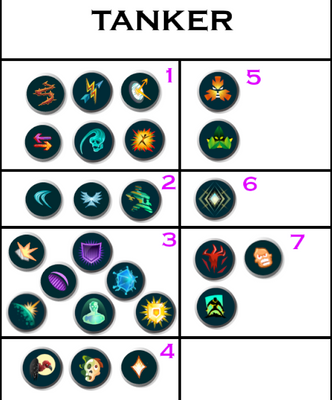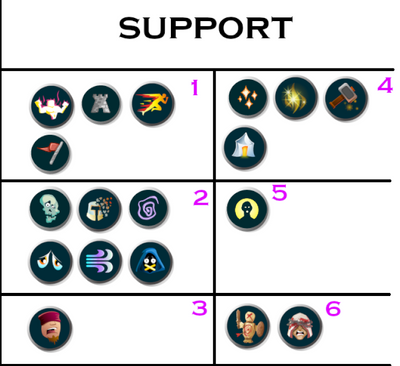Continuing from the second update on Traits Mapping series (click here for Update 2 post, and here for Update 1 post). This post will give detailed information about the sub-groups of abilities, and the reason behind putting them.
1. STRIKER ABILITIES

Striker abilities are basically abilities which boost and affect the direct attack of the owner. These abilities are differ from Tanker and Support, since they both could be triggered even when the cards does nothing. These major grouping are divided into 8 (eight) sub-groups, which is:
- Target Altering Abilities
These subgroup consist of type of abilities which extend the attack range or alter the target of the card. It consist of Scattershot, Snipe, Sneak, Opportunity, Reach, and Close Range. - Damage Booster Abilities
These subgroup consist of abilities which double the damage upon certain conditions. Fury, Oppress, Giant Killer, Deathblow, and Knock Out belong to this subgroup. - Status Ailments Abilities
These subgroup consist of abilities which caused various effect (other than damage) if hit the target. The attack must hit the target for the effect to applies. Stun, Affliction, Poison, Shatter, Cripple, Halving, and Dispel belong to this subgroup. Only Stun, Affliction, and Poison which have 50% chance to applies each time a hit is done. - Accuracy Booster Abilities
This subgroup consist of True Strike and Snare; both of which ensure 100% hit on target. - Momentum Abilities
This subgroup alter the timing of an attack is executed. It consist of abilities which automatically trigger two successive attack in single turn (Double Strike), or trigger single attack every two turns (Recharge). - Trample
Stampede have no certain subgroup since this ability is unique and no other abilities are similar to this. The ability are triggered every time the card score a kill. - Piercing
Piercing also unique, since this ability distribute any excess damage against armor into the health. - Blast
Blast would also be stand-alone, since this the only ability to deal indirect damage through a hit from direct attack.
2. TANKER ABILITIES

Tanker abilities are basically any abilities which empower and protect the owner; and were different from Support abilities in that these abilities only affect the owner solely and not other cards. These type of abilities also triggered either automatically or from each hit sustained from incoming attack (except for Life Leech and Bloodlust which still need the owner to deal a hit to get triggered). These major grouping are divided into 7 (seven) sub-groups, which is:
- Counter Abilities
These type abilities will trigger a return damage on certain conditions based on incoming attack or hit received by the owner. Thorns, Return Fire, Magic Reflect, Retaliate, Backfire, and Redemption are under this sub-group. Redemption is the only one to triggered once the card got eliminated. - Evasion Booster Abilities
Evasion Booster boost the chances for the owner to avoid incoming attack. It consist of Dodge, Flight, and Phase. This sub-group are the contra-abilities of Accuracy Booster sub-group mentioned before. - Defensive Abilities
This sub-group consist all kind of abilities which will reduce the value of damage taken or eliminate other negative effect. This sub-group would consist of Shield, Void, Void Armor, Reflection Shield, Force Field, and Immunity. Having Reflection Shield will nullify several effect from Counter sub-groups, meanwhile having Immunity will nullify several effects from the Status Ailments sub-groups. - Health Booster Abilities
This group trigger effect which related to health, either add health (Scavenger or Life Leech) or mend health (Heal). - Redirection Abilities
Its the inverse sub-group of the Target Altering sub-group. It consist ability which alter the incoming attack, either attract attacks (Taunt) or repel attacks (Camouflage) - Amplify
Amplify is placed stand-alone since this is an unique ability which trigger would depend on the Counter Abilities sub-group. This is a very difficult ability to use since most of the cards which possessed this ability didn't possess the Counter Abilities. - Empower Abilities
Empower sub-group would consist abilities which boost the owner similar to Health Booster, but rather than health, these abilities includes status outside health. It consist of Bloodlust, Enrage, and Last Stand.
3. SUPPORT ABILITIES

This major group will encompass the remaining abilities other than the two major groups above. This group will consist abilities which provide certain benefits into the owner formation, but where the application is more general to entire cards (rather than the owner solely). So fat this major group are divided into 8 (eight) sub-groups, which is:
- Buff Abilities
This sub-group will consist of all kind of status addition for each parameter (armor, health, speed, and damage). For damage addition only melee type available (Inspire). - Debuff Abilities
This sub-group will consist of all kind of status reduction for each parameter (armor, health, speed, and damage). This sub-group have the complete collection including for all three damage type (Demoralize, Headwinds, and Silence) - Blind
Blind are separated from Debuff Abilities, since this ability will reduce accuracy which not related with parameter. - Mend Abilities
Mend abilities consist of abilities which recover the armor and health of other cards. This sub-group consist of Tank Heal, Cleanse, Repair, and Triage. - Resurrect
Resurrect should be a stand-alone ability since this is a unique one which able to give second chance to any destroyed cards. - Rally Abilities
This sub-group consist of the new abilities coming from Soulbound editions. The abilities will boost allies cards (other than the owners) either automatically from the start (Weapon Training) or after the owner demise (Martyr).
Notes: This abilities grouping are made based on the abilities owned by monster cards rather than the summoner. For example consider Amplify and Divine Shield; both abilities will only applies to the monster card owning such, but if owned by a summoner it would applies to entire card in a formation.
CONCLUSION
Grouping all of the abilities into major groups and sub-groups not only help us to remember each and every abilities, but also ease the mind when setting up strategy for any battle. I used this grouping to help maps the strength and weakness of certain collections. In my Traits Mapping post, I conclude that certain collection have tendency to possess certain type of abilities.
This is some great info. I'm not sure why no one has done this before.